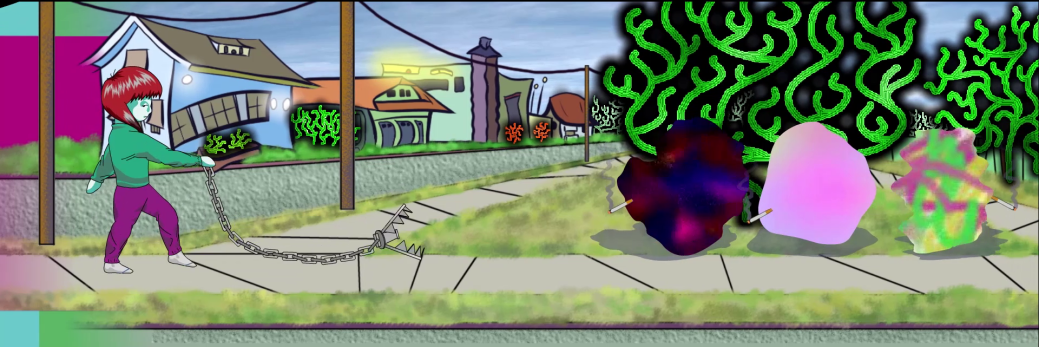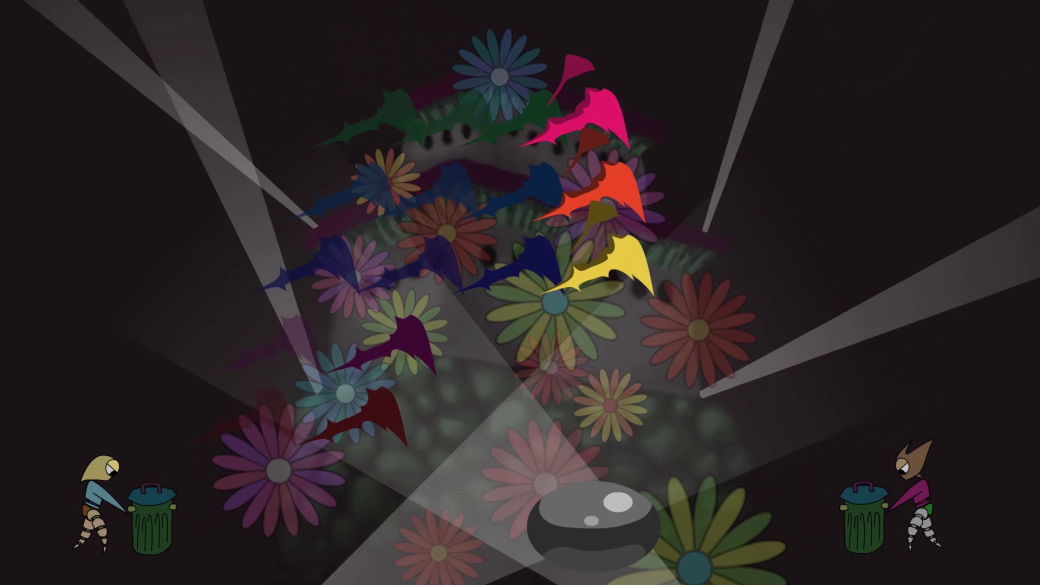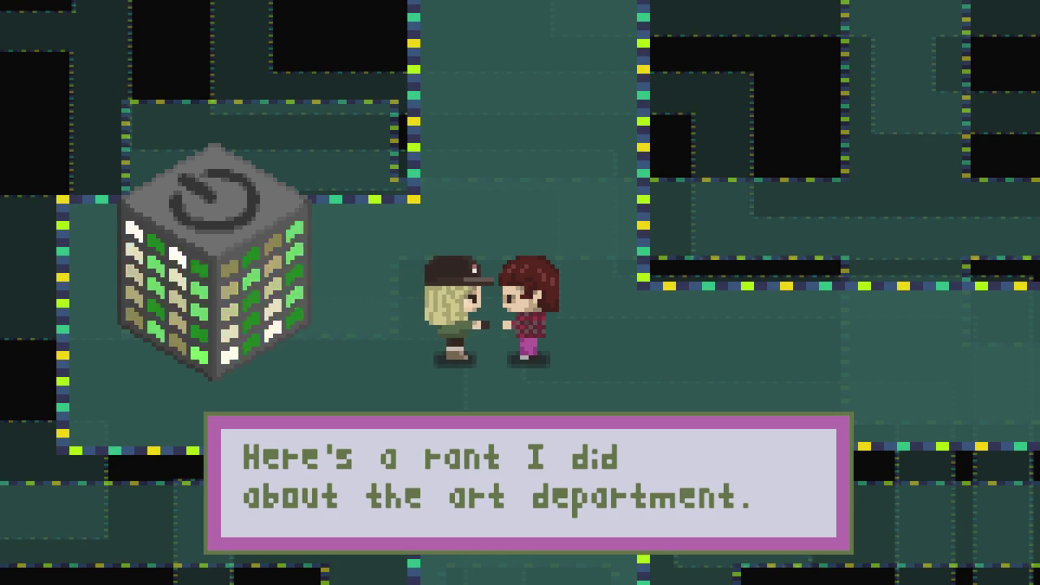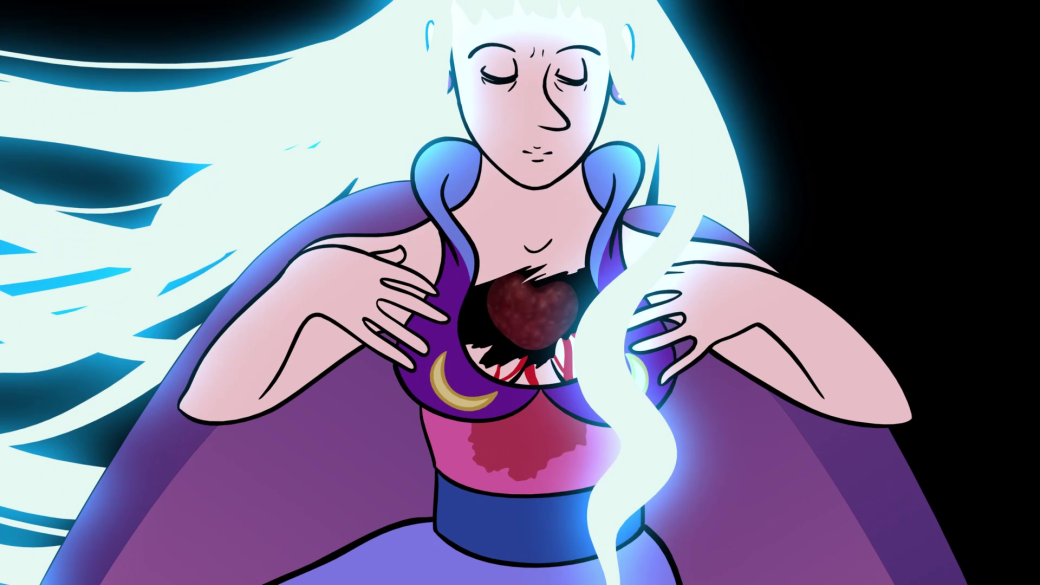
Amy’s Walk (2014)
I remember when my partner Chris first told me, a year and a half ago, about the enormously talented queer animator taking his Time-Based Art class. Sierra Tucker seems to have arrived at our university already skilled in various techniques and technologies of animation and in possession of a fresh and distinctive artistic sensibility. Since then she has continued to work closely with Chris, including now as the TA for his course in Experimental 2D Animation, and I’ve had the pleasure of getting to know her as well through two of my courses in film studies.
Sierra is entirely self-motivated; in other words, she doesn’t seem to need the structure of assignments and deadlines to make work. With a student like her, the role of a “teacher” is to give her the support she needs and then get out of the way. Next month she will graduate from Western with a BA in Studio Art, and I have no doubt that great things lie in store for her after graduation.
On Tuesday, February 20, at 6:30pm, Chris and I will present a program of Short Animations by Sierra Tucker as part of our monthly queer film series, the Queens’ Vernacular, at Pickford Film Center. What follows is an overview of the six videos featured in the program followed by an interview with Sierra about her background and influences and about the methods and ideas behind her work.
Sierra’s art is trippy, dazzling, funny, and humane. Her style of animation is stunningly eclectic, though a strong current of 1990s fashion, video-game, anime, and rave iconography runs throughout. The first three videos in the program feature one of her alter egos, Amy. In Amy’s Walk (2014), we watch the heroine’s sidescroll journey with her pet bear trap through a number of distinctly drawn environments. It’s a great introduction to the artist’s stylistic diversity and her prodigious range of inspirations and influences. The pleasure continues with Sleeve Fray (made in spring 2013, when Sierra was still in high school) and Synesthesia Light Show (2017), where Amy’s journey crosses over into psychedelic dreamscapes and kaleidoscopic abstract animations. Sierra is also a talented musician. With the exception of Sleeve Fray, which uses Radiohead’s song “Treefingers,” all the videos in the program are set to her own compositions.
The fourth video, TRANS FAIRY’S MOVIE (2016), brings the queer sensibility behind Sierra’s other work to the foreground. The hilarious piece sends up some of the more stultifying aspects of queer life on a college campus, including the policing of other people’s identities, the demand and expectation of certain kinds of self-narratives from trans people but not others, and the often-blanketing earnestness of university-sanctioned safe spaces and talent shows. Another explicitly queer work, though one that is not included in the program, is the layered found-footage piece that Sierra made for my spring 2017 Trans Film and Media Studies course in which she explores the abuse speedrunner Narcissa Wright has faced in online forums after coming out as a trans woman. In general, though, Sierra’s queer sensibility moves away from explicitness and into her play with visual forms, her music, and (as she describes in the interview below) her voice and character work. The fifth video in the program, The Core (2017), is probably the best showcase of the latter.
Many of Sierra’s animations explore personal visions and feelings. Watching them, one often has the sense of a brilliant artist and musician working long hours on her own with a computer. Recently, though, she created a more outward-facing and longer-form work: the thirty-minute animated documentary Names (2017). In the video, an avatar of Sierra navigates a 2D video-game space where she engages in conversations with other avatars based on her classmates and teachers at Western. With each conversation, a differently animated space opens up to represent the other person’s story and experiences. It’s a beautiful piece about interpersonal communication, the risks of self-exposure, and the process of building a community. It also represents a new direction in Sierra’s work. For these reasons, it ends and anchors the program.
The following interview was conducted on Friday, February 2. I sat down with Sierra to ask her five questions I had devised with Chris and to listen as she expanded on key aspects of her practice. She and I then collaborated over email to get the transcript into a more succinct and readable shape.

Sleeve Fray (2013)
Could you tell us a bit about your background? Where are you from and when did you start making art?
I’m from Walla Walla, Washington, which is a small town in eastern Washington. My parents had a really big influence on the art that I did growing up because they were supportive and they provided a lot of resources and encouragement for me. My dad showed me how to do a lot of things on the computer and showed me how to draw various things on paper and just trained me in many different types of skills. My siblings and I would also make little movies. I would usually be directing and they would be acting. We would film them on an old camera and they would go onto little cassette-tape-sized videotapes.
Another big influence on the type of art I do is that my parents have the habit of keeping everything. So old clothes, or schoolwork, or letters, or pictures that I’d drawn—anything like that would go into storage. A lot of my art has this same desire behind it: to capture things and store them so that I can come back to them later and still have them even after they’re gone.
The first animations I did were on the computer in a 3D modeling software. That’s something my dad showed me how to do when I was about seven or eight years old. Around the same time, he showed me how to do stop motion, and I did that with Legos. My drawings didn’t go into animation for a long time because it seemed hard to me.
Later I was in a digital media class in high school and they taught us Flash animation as one of the units. I did a short little animated video called A Day in the Life of Brownbird. Also, about a year or two after that class, a teacher I had was holding a film festival and I wanted to make an animation for it but had no idea what to do. I had been doing a lot of writing but wasn’t drawing much at the time, so the animation I made mostly drew from my writings. I used tracing paper so that I’d be able to see through to previous frames while drawing. I drew it in pen and then scanned it into the computer and assembled it digitally.

Synesthesia Light Show (2017)
The animation styles in your videos are very diverse. Video game iconography is clearly a major influence. Can you talk about its significance to you and about what else inspires you?
Well, I’ll start with the easy part. My video game influences mostly come from the era that I grew up playing games, which was 1996 to the mid-2000s, and it was on the Nintendo 64, which was the first 3D gaming system. Nintendo is a Japanese company and a lot of the games are made in Japan, so a lot of Japanese culture comes through in them. The games are not exactly a one-to-one stylistic inspiration for my animations because mine are mostly in 2D, but a lot of the types of movement and subject matter and special effects and that kind of stuff come from that era in video games. Japanese anime is also a big influence. I haven’t seen a ton, but I’ve seen just enough to where I’m influenced by it, including a few that I’ve gotten really into like Serial Experiments Lain and a couple of others.
One of my favorite games when I was little was The Legend of Zelda: Ocarina of Time, just because it was so mysterious to me. I was playing it when I was really young, so I still hadn’t figured out what a lot of things meant and I also couldn’t read. There would be times when I was playing that game when I had no idea who people were and what was going on, which made it really surreal for me. I’m inspired by that feeling of surrealness, of mystery, and of seeing a bunch of things that make it look like something is going on but you’re not familiar with it.
I get some visual influence from animations and video games and movies and stuff like that, but my art is always driven by a desire to show things in the way that I see them. It comes from real life experiences where I’m blown away by something and want to capture the feeling that it gives me. What goes into that isn’t necessarily about creating a sense of realism. Instead it’s about creating the same sensation that I get when I see things, and I take a lot of effort to figure out the best way of doing that. That’s how the abstraction and surreal parts come out in my art, because I want to accurately capture experiences and feelings and those are not always reflective of the physical world. That’s a huge driving force behind everything that I do.

TRANS FAIRY’S MOVIE (2016)
A few of your pieces engage explicitly with trans identity and experience, but a lot of your work doesn’t, or at least doesn’t do so overtly. To what extent is your identity as a trans person important to your art? How does it come into the work for you?
I would say it’s a very large part, even though I don’t touch on it in the content of the work. It’s a large part because it dictates how my life is to an extent, in that I have to face a lot of things that other people are not familiar with, and so it makes me an outsider in a way.
Being trans also affects a lot of the decisions that I make regarding characters. My main characters, and all my characters really, are just different parts of me. It might be a part of me that someone else has influenced, so a piece of someone else might be in there, but it’s always a part of me.
Amy’s an interesting case because I started doing stuff with Amy before I’d even thought about the possibility of being transgender. Amy was just a female character that I had and I was drawing her when I considered myself a boy, but she was still doing the exact same things that I had done in my life. So it was still a stand-in for me, but I didn’t make a one-to-one connection with it. But now I’ve grown into thinking of Amy as more of a literal version of myself, and it has affected the way I grow my hair and stuff like that. So I think I use characters to express my identity.
And sometimes I use them as an avenue for identity empowerment too. In The Core I had this woman character, Sylvia Deadfish, and through her I tried to exercise my voice, my physical voice, and sing in a different way. I used the character to present my voice as belonging to a woman and to help me grow into this new role that I was living. I drew her with breasts and really long glowing hair and really feminine qualities—things that I felt were an expression of my gender identity in a way. I did give her big feet though, because I also wanted to push the idea that women can have non-ladylike physical qualities and still be women.
Through the process of trying to change my voice, I get a sense of what my voice is and isn’t capable of. I get a sense of the range that my voice has and the different character voices I can do. It gave me an opportunity to become more serious about voice acting, because in a way I was trying to voice-act my own life because I wanted to will my voice into becoming something else. So I became a lot more serious about the physical aspects of my voice and how to harness them.
For a while, when I first started transitioning, I was really opposed to the idea of ever doing anything masculine or having any masculine characters represent me. But my attitude towards it has changed over time. I have this really butch side to myself, and I embrace it now. And when I’m voicing male characters, it doesn’t mean anything different to me about my gender. I used to worry about things like that, but I don’t any more. I like having that aspect of me. I like being able to shape-shift what kind of characters I’m doing.

Names (2017)
At the end of Names, a scrolling text seems to present your philosophy about human communication. It talks about people being vehicles, and how each person has so much inside of them that can never get out adequately or completely; and how when things do come out, they often come out in unpredictable or unorthodox ways that are liable to be misread. Part of the text reads, “Talking about it is messy because communication happens through symbols, which are simplified versions of things. A circle with two smaller circles and a line equals a face. The problem is that the things to be communicated are a river and we’re trying to drink it with cups.” Can you talk a bit about Names and its emphasis on communication and community-building? Where did the idea for the video come from and what were your goals in making it?
I always felt, growing up in public school, that other people knew how to talk but I didn’t, and it was confusing to me. I think there were a couple of big reasons why I was isolated, and I think they’re related to the project so I’ll bring them up. One was because I was really emotionally sensitive, and sometimes people don’t know how to deal with that. Because, you know, people get mad or they cry and then you don’t know how to react—and I would get mad and cry a lot when I was little. The other thing is I believed in myself and sometimes that would manifest as having a big ego. People with a big ego don’t always mix well with other people. So I spent a lot of time feeling like I didn’t fit in.
Names draws from those feelings and issues that I’ve dealt with throughout my life. But it also draws from working long hours. I think this is the practical, immediate thing that caused the project, because at that point I had done all these animation projects in college and put so much work into them and spent so much time alone and no time socializing. So I told myself that because this is what I’m doing, I have to bring people into my animations if I want to have people in my life. So that was a motivation for the project.
The original idea for Names was to capture quirks that people have. So anything someone does that’s a repetitious movement that they do all the time, or something that they say that’s funny, or something that they focus on, I had a big interest in that. Originally a lot of it was for humorous value, but there was a more serious investment in it too.
I wanted to learn how to focus on other people as opposed to myself. I had done a lot of introspection in my animations leading up to Names, and I was looking back at them and thinking I needed to broaden my horizons, that I have a responsibility to the world and also to myself to get some new perspectives. A big part of Names was learning a new skill, which was listening. I wanted to learn how to listen to people and ask them questions that were spontaneous, questions that would go off of things they had said in order to hone in on what’s important to them. It’s a process of learning about people by paying attention to the things they say and letting that guide my questions. I was trying to hone that skill in myself.
At the end of everyone else’s interviews, I wanted to put a piece of myself in the video, so that my thoughts could be seen as well. So the collection of paragraphs that scroll by at the end was my interview. The idea about things being inaccurately expressed comes from the experience I talked about of being little and feeling like everything I said was a little off and I didn’t know how to speak. And I think that that’s true for a lot of people, to a degree, because words are a vehicle for our thoughts, and they’re not the thoughts themselves all the time. Sometimes people think in words, and sometimes they just have reactions and they try and put words to them. I’ve been misunderstood a lot for things that I’ve said and done, and I think that that’s a really sad thing to happen to someone. So by pointing out the limited nature of words, I hope to get people to see past the words and ask, what is the intent of the person saying them, and where’s that person coming from? Why would they be saying this?
At the same time, I don’t personally have a goal for the video anymore. I think it’s great to show it to people because people seem to like it, but it was kind of a first step for me into something bigger.

The Core (2017)
So what’s next then? Now that you’re about to graduate, what do you envision for your next artistic projects and for your future as an artist?
I am currently on an art hiatus, though I have plans for my next animation, which I’m going to start working on after I get out of school. I’m already kind of working on it because I’m organizing people who are going to help me. The project is called Flatworld. It’s going to take some of the technical things I started experimenting with in my earlier animations and really expand on them, like the idea of merging two-dimensional and three-dimensional objects and spaces and having them coexist throughout, and also the idea of merging flat digital-looking things with painterly things. It’s also going to have a much more fleshed-out film score, one that’s really cinematic and has a lot of orchestral elements.
I’m also expanding on the idea of having other people do things for the animation. In a way I did that with Names when I used other people’s voices, and I also did it in The Core when I had my friends and family draw robots for me for the very last segment of the video. So I’m focusing on finding talented people and putting them to work and not paying them. (Laughs.) A theater teacher I know at Western helped me send out an audition request to all the theater majors, and my inbox was flooded with people wanting to audition for this thing, and I can only choose one of them so it’s going to be fierce competition to see who gets it. The role that I’m auditioning for is for the narrator in the opening section. I want to get to know the people who are auditioning, so I’m going to try and do the same type of thing that I did when I was making Names and was interviewing people, where my goal was to learn as much about them as I can in a short period of time. It’s going to be mostly about getting to know who they are, and then also getting a sample of how they sound when they’re reading from a script.
I also have a couple of artist friends who are helping me with the project. Hunter Long, who is a musician and a multimedia artist here at Western, is doing a musical piece that’s going to be in the middle of it. He’s also voicing one of the characters. And Keara Mulvihill, who’s a painter here at Western, is going to paint forest creatures and spirits, and I’m going to take those different disjointed pieces and put them together and animate them. I’m thinking too of having people contribute 3D models or other character drawings, just to build a community around the project and make something collaborative. Because the best things happen when you have a wide variety of sources.
That’s part of where my diverse styles come from. I like to have as wide a range of source material as possible, because I think when a lot of very distinct things are put together it makes something that is very unique. So I’m going to focus on figuring out ways that I can have other people do a lot of the work in this project. Because I’ve established that I can make good animations on my own, but I want to make stuff that’s bigger and involves more people.